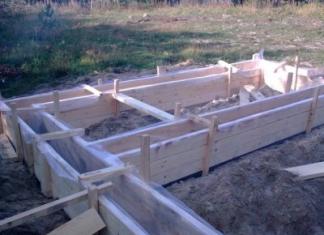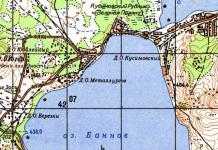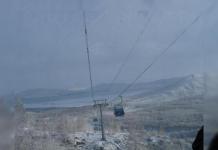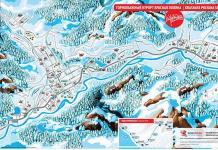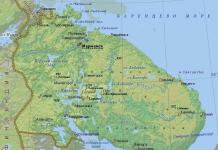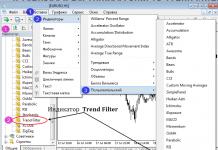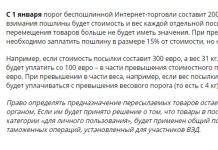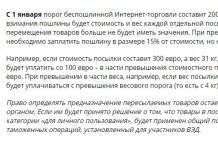The effect of dust on the body
Dust has a fibrogenic, toxic, irritating, radioactive, allergenic, carcinogenic, photosensitizing effect. Occupational dust diseases of the lungs - pneumoconiosis - one of the most severe types worldwide. occupational diseases.
The main dust occupational diseases are:
1. Pneumoconiosis.
2. Chronic dusty bronchitis.
3. Dust diseases of the upper respiratory tract.
Pneumoconiosis- chronic occupational dust lung disease, characterized by the development of fibrotic changes in them as a result of prolonged inhalation action of fibrogenic industrial aerosols.
According to the etiological principle, the following types of pneumoconiosis are distinguished:
1. Silicosis - pneumoconiosis caused by inhalation of quartz dust containing free silicon dioxide.
2. Silicosis - pneumoconiosis arising from the inhalation of dust of minerals containing silicon dioxide in a bound state with various elements.
3. Metalconiosis - pneumoconiosis from exposure to metal dust (siderosis, aluminosis, baritosis, staniasis, manganoconiosis, etc.)
4. Pneumoconiosis from mixed dust (with a content of free silicon dioxide more than 10 and less than 70%).
5. Pneumoconiosis from organic dust: vegetable (byssenosis - from cotton and flax dust; bagassosis - from sugar cane dust; farmer's lung - from agricultural dust containing mushrooms), synthetic (plastic dust), from exposure to soot - industrial carbon.
The most common severe form of pneumoconiosis is silicosis. Occurs in workers exposed to industrial dust containing silicon dioxide. Silicosis develops at different times of work under dust exposure. The prevalence, rate of development of the disease and the degree of its severity depend on working conditions, dispersion, and concentration of quartz dust. The mechanism of action of dust on the respiratory tract and the development of the fibrogenic process in the lungs can be explained from the standpoint of the type of dust, its physical and chemical properties.
The pathogenesis of dust lung diseases is complex. Theories of the pathogenesis of silicosis can be conditionally divided into three groups:
1. Mechanical.
2. Toxic-chemical.
3. Immune-biological.
At present, theories are most recognized, according to which the main mechanisms of action of quartz dust are phagocytosis, the direct effect of quartz particles, which have chemically active radicals on their surface, on the cytoplasm of macrophages, causing damage to the membranes of intracellular organelles. This last disrupts the processes of energy metabolism in the lung tissue with the subsequent development of collagens.
Silicosis is characterized by the development of nodular or diffuse pulmonary fibrosis. Pathological phenomena increase slowly. Clinical symptoms do not always correspond to the severity of the pneumofibrotic process, therefore, radiological data are of primary importance for diagnosis.
Silicosis is a common disease of the body, in which, along with a violation of the respiratory function, the development of emphysema, chronic bronchitis, "cor pulmonale" is observed. Changes in immunological reactivity, metabolic processes are recorded. Violations of the activity of the central and autonomic nervous system.
Among the complications of silicosis are asthmatic bronchitis, bronchiectasis, bronchial asthma. The most common and severe complication of silicosis is tuberculosis, which leads to a mixed form of the disease - silicotuberculosis. Characteristic of silicosis is its progression even after the cessation of work in the dust industry.
From other forms of pneumoconiosis, silicosis develops in more late dates are less prone to progression and complications. They have a brighter clinical picture and a less clear radiological one. One of the most aggressive forms of silicatoses is asbestosis- in the later stages, in 15-20% of cases it can be complicated by the development of lung cancer.
With high dust content in the air in mines, miners may develop pneumoconiosis as a result of inhalation of coal dust - anthracosis. Its course in comparison with silicosis is more favorable, the fibrous process in the lungs proceeds according to the type of diffuse sclerosis. Inhalation of mixed coal dust and rock containing free silica causes anthracosilicosis, a more severe form of pneumoconiosis compared to anthracosis.
Industrial dust can cause not only pneumoconiosis, but also other diseases of the respiratory apparatus, skin, and mucous membranes. These include: dust bronchitis, bronchial asthma (from wood, flour dust, dust of some organic compounds), pneumonia (thomaslag dust, dust of manganese compounds); lesions of the nasal mucosa and nasopharynx (cement dust, chromium compounds); conjunctivitis, skin lesions - peeling, coarsening, acne, furunculosis, and sometimes eczema, dermatitis (wood, grain, hair dust, etc.).
Prevention of dust diseases
1. Hygienic regulation. The basis for carrying out measures to combat industrial dust is hygienic regulation. In our country, maximum concentration limits for fibrogenic dusts in the air of working premises have been established, the requirement to comply with which is the basis for the implementation of preventive and current sanitary supervision. Control over the state of the dust level is carried out by the laboratories of the State Sanitary and Epidemiological Supervision, factory sanitary and chemical laboratories. The administration of enterprises is responsible for maintaining conditions that prevent the excess of the MPC of dust in the air. Considering that dust containing free silicon dioxide is the most aggressive among fibrogenic aerosols, MPC of such dusts depends on its percentage. Thus, when the content of free silicon dioxide in the dust is more than 70%, the MPC will be 1 mg/m 3 , with a content of 10 to 70% - 2 mg/m 3 , with a content of 2 to 10% - 4 mg/m 3 .
2. Technological measures. The main way to prevent dust lung diseases is to eliminate dust in the workplace by changing production technology, that is, reducing dust formation. The introduction of continuous technologies, automation and mechanization of production, remote control contributes to a significant improvement in working conditions.
effective means dust control are the use in the technological process instead of powdery substances - briquettes of granules, pastes, solutions, etc., as well as the replacement of "dry" processes with "wet" ones.
3. Sanitary measures. Measures of a sanitary nature are aimed at removing dust directly from places of dust formation. They play an essential role in the prevention of dust diseases. These include local shelters for dusty equipment with air suction, local exhaust ventilation. The dusty air must be cleaned before being released into the atmosphere.
4. Personal protective equipment. In cases where measures to reduce the concentration of dust do not lead to a decrease in dust in the working area to acceptable limits, it is necessary to use personal protective equipment. Personal protective equipment includes anti-dust respirators, goggles, special anti-dust clothing. The most widely used respirator type "Petal". In case of contact with powdery materials that adversely affect the skin, protective ointments and pastes are used. Use goggles or goggles to protect your eyes. From overalls dustproof overalls are applied.
5. Therapeutic and preventive measures. In the system of recreational activities, medical control over the health of workers is very important. In accordance with Order No. 90 of the Ministry of Health of the Russian Federation dated March 14, 1996, it is mandatory to conduct preliminary medical examinations upon admission to work and periodic medical examinations. All forms of tuberculosis, chronic respiratory diseases, of cardio-vascular system, eyes and skin.
The main task of periodic examinations is the timely detection of the early stages of the disease and the prevention of the development of pneumoconiosis, the determination of professional suitability, and the most effective therapeutic and preventive measures. The timing of inspections depends on the type of production, profession and the content of silicon dioxide in the dust.
Biological methods of prevention are aimed at increasing the reactivity of the body and accelerating the removal of dust from it. The most effective is ultraviolet irradiation in photoria, which inhibits sclerotic processes; alkaline inhalations, which contribute to the removal of dust from the respiratory tract, sanitation of the mucous membranes. Respiratory gymnastics, sports that improve the function of external respiration also prevent the development of pneumoconiosis. The diet in the organization of nutrition should be aimed at normalizing protein metabolism and inhibiting the silicotic process. For this purpose, methionine and vitamins are added to it, which activates the enzyme and hormonal systems and increases the body's resistance to the pathogenic effects of dust.
Control questions on the topic of the lesson
1. Classification of dust by formation, origin, dispersion.
2. What indicators characterize the dust.
Figure 2.1 - Protective and dust-removing casing Figure 2.2 - Dust collector
for drilling machines
Technological equipment, in particular metalworking machines, are equipped with dust collectors; whose design is shown in Fig. 1.2
Organizational. Time protection when exposed to predominantly fibrogenic aerosols (APFD). To assess the possibility of continuing to work in specific working conditions, to calculate the allowable length of service in these working conditions (for newly hired people), it is necessary to compare the actual and control levels of dust load.
In the event that the actual PV do not exceed the CIT, the possibility of continuing work under the same conditions is confirmed.
If the CIT is exceeded, it is necessary to calculate the length of service (T1), at which the CIT will not exceed the CIT. At the same time, it is recommended to determine the CIT for an average work experience of 25 years. In cases where the duration of work is more than 25 years, the calculation should be made based on the actual length of service.
where T1 - allowable length of service in these conditions;
KPN25 - control dust load for 25 years of operation under the conditions of compliance with MPC;
K - actual average shift concentration of dust;
N is the number of shifts in a calendar year;
Q is the volume of pulmonary ventilation per shift.
In this case, the value of K is taken as a weighted average value for all periods of work:
where K1 - Kn - actual average shift concentrations for individual periods of work;
t1 - tn - periods of operation during which the actual dust concentrations were constant.
The Q value is calculated similarly to the K value.
In the event of a change in the levels of dust content in the air of the working area or category of work (volume of pulmonary ventilation per shift), the actual dust load is calculated as the sum of the actual dust loads for each period when these indicators were constant. When calculating the control dust load, the change in the category of work in different periods of time is also taken into account.
Sanitary and hygienic measures. The inner surfaces of walls, floors and other enclosures of working premises, where dust can be released, should be lined with a smooth building material that makes it easy to remove and sometimes wash off settled dust.
Dust should be removed either wet or by aspiration (industrial vacuum cleaners or suction into a vacuum line).
Therapeutic and preventive measures: medical examinations, periodic (at least 2 times a year) x-ray control of the lungs of all persons whose profession is associated with the inhalation of industrial dust. If the initial stage of silicosis or tuberculosis is detected, the patient should be transferred from work associated with exposure to dust, sent to a sanatorium, where timely treatment should be started. Patients with initial forms of silicosis must be registered in the dispensary, and after they leave work associated with dust, continue monitoring them to prevent the development of late silicosis and silicotuberculosis.
The main task of periodic examinations is the timely detection of the early stages of the disease and the prevention of the development of pneumoconiosis, the determination of professional suitability and the implementation of the most effective therapeutic and preventive measures. The timing of inspections depends on the type of production, profession and dust content. Examinations by a therapist and an otolaryngologist are carried out once every 12 or 24 months, depending on the type of dust, with mandatory chest x-ray and large-frame fluorography.
Among the preventive measures aimed at increasing the body's reactivity and resistance to dust damage to the lungs, UV irradiation inhibiting sclerotic processes is the most effective. Alkaline inhalations that promote sanitation of the upper respiratory tract, breathing exercises, which improves the function of external respiration, a diet with the addition of methionine and vitamins.
Indicators of the effectiveness of anti-dust measures are a decrease in dustiness, a decrease in the incidence of occupational lung diseases.
Personal protective equipment against dust. In cases where measures to reduce the concentration of dust do not lead to a decrease in dust in the working area to acceptable limits, it is necessary to use personal protective equipment. Personal protective equipment includes anti-dust respirators, goggles, special anti-dust clothing. The choice of one or another means of respiratory protection is made depending on the type of harmful substances, their concentration. Respiratory organs are protected by filtering and isolating devices. The most widely used respirator type "Petal".
Figure 3.1 - Respirator type "Petal"
Use goggles or goggles to protect your eyes. Closed-type glasses with durable shatterproof glasses are used in the mechanical processing of metals (cutting, chasing, hand riveting, etc.). When processes are accompanied by the formation of fine and solid particles and dust, metal splashes, closed-type goggles with sidewalls or masks with a screen are recommended. On fig. 3.1, 3.3 shows some types of glasses.
Figure 3.2 - Models of eye protection glasses with and without shields
Figure 3.3 - Examples of goggles for eye protection
From overalls, dust-protective overalls are used: women's and men's with helmets for performing work associated with a large formation of non-toxic dust, suits - men's and women's with helmets (Fig. 3.4).
According to GOST 29057-91 “Men's suits for protection against non-toxic dust. Specifications” and GOST 29058-91 “Women's suits for protection against non-toxic dust. Specifications" for the manufacture of overalls and helmets, bleached and one-colored molexin is used
Figure 3.4 - Anti-dust suits - male and female with helmets
3 MEASURES AIMED TO REDUCING THE HARMFUL SUBSTANCE DUST AT THE WORKPLACES OF THE TURNER STANDARD LLC
Conclusion
Time protection.
One of the measures to limit the impact of the harmful substance dust on the human body is time protection.
The main indicator for assessing the degree of impact of APFD on the respiratory organs of a worker is the dust load.
The actual average shift concentration of metal dust at the turner's workplaces (2 workplaces) K = 5.6 mg/m3: MPC = 4 mg/m3.
Dust load (PN) on the respiratory organs of a worker is the actual or predicted value of the total exposure dose of dust that the worker inhales for the entire period of actual (or assumed) professional contact with dust.
The dust load on the respiratory organs of workers (2 turners) is calculated based on the actual average shift concentrations of APFD in the air of the working area, the volume of pulmonary ventilation (depending on the severity of work) and the duration of contact with dust:
PN \u003d KNTQ, mg
where K is the actual average shift concentration of dust in the worker's breathing zone, mg/m; K = 5.6 mg/m3;
N is the number of work shifts worked in a calendar year under the influence of APFD; N = 248 shifts;
T is the number of years of contact with APFD;
turner 1 - T = 5 years;
turner 2 - T = 8 years;
Q is the volume of pulmonary ventilation per shift, m. It is recommended to use the following average values of pulmonary ventilation volumes, which depend on the level of energy consumption and, accordingly, the categories of work in accordance with SanPiN 2.2.4.548-96 ("Hygienic requirements for the microclimate of industrial premises"); for works of category IIa-IIb Q = 7 m.
PN = 5.624857 = 48608 mg
PN = 5.624887 = 77772.8 mg
The obtained values of the actual PL are compared with the value of the control dust load (CPL), which is understood as the dust load formed under the condition of compliance with the average shift MPC of dust during the entire period of occupational contact with the factor.
Control dust load for the same period:
CPN \u003d MPCs NTQ, mg
where PDKSS is the maximum permissible average shift concentration of dust, mg/m3
For turner 1:
CPN = 424857 = 34720 mg
For turner 2:
CPN = 424887 = 55552 mg
The frequency of exceeding the control dust loads indicates the class of harmfulness of working conditions according to the factor - dust. We calculate the value of excess CIT.
For turner 1:
For turner 2:
The class of working conditions is determined in accordance with R 2.2.2006-05.
Table 3.1 - Classes of working conditions depending on the content of aerosols of predominantly fibrogenic action (APFD) in the air of the working area and dust loads on the respiratory organs (multiplicity of exceeding the MAC and CPN)
Aerosols | Working condition class |
|||||
Permissible | Dangerous** |
|||||
High and moderate fibrogenic APFD*; dust containing natural (asbestos, zeolites) and artificial (glass, ceramic, carbon, etc.) mineral fibers | ||||||
Weak fibrogenic APFD** | ||||||
* Highly and moderately fibrogenic dusts (MPC2 mg/m). ** Weakly fibrogenic dust (MPC2 mg/m). *** Organic dust in concentrations exceeding 200-400 mg/m poses a fire and explosion hazard. |
||||||
The class of working conditions of a turner is 3.1, i.e. working conditions are characterized by such deviations in the levels of harmful factors from hygienic standards that cause functional changes, which are restored, as a rule, with a longer (than by the beginning of the next shift) interruption of contact with harmful factors and increase the risk of damage to health.
d) We determine the control dust load for the period of 25-year contact with the factor (KPN25):
CPN25 = 4248257 = 173600 mg
e) We determine the allowable length of service in these conditions according to the formula:
Т = KPN25/ (КNQ), years
T = 173600 / (5.62487) = 17.9 years
Thus, the allowable work experience of a turner under these conditions is 17.9 years.
The work experience of a turner is 1 - 5 years, which means that he can work in this profession no more than 12.9 years
The work experience of a turner is 2 - 8 years, which means that he can work in this profession for no more than 9.9 years.
Technical measures
We suggest using local ventilation.
Let us determine the amount of air required to continuously remove dust from the cutting tool. We carry out the calculation according to
gb=gc / kg/h,
where Gc is the amount of chips separated from the workpiece - Gc, kg/h (machine time); because we do not have the opportunity to measure this value directly at the turner's workplaces (2 workplaces), then we take into account Gc = 110 kg / h;
The concentration of the mixture, kg / kg, take 1, according to;
gb=110 / 0.6 = 184 kg/h,
Let us determine the minimum volume of air required to transport chips at one workplace:
LВ=GB/B, m3/h
where B is the specific mass of air at the temperature of the transported mixture, kg/m3, take 1.2 kg/m3, according to .
LВ=184 /1.2 = 154 m3/h
Since there are two jobs, then LВ=154 2 = 308 m3/h.
We select the FVU-2400 electrostatic filter, the technical characteristics of which are presented in table 3.2
Table 3.2 - Specifications, operating parameters and overall dimensions of FVU-2400
Specifications FVU-2400 | FVU-2400 parameters |
Productivity, m³/hour, | |
The size of the captured particles, microns, | |
Degree of purification by solid particles, %, not less than | |
Active filtering surface, m² | |
Weight, kg, no more | |
Overall dimensions, mm | |
Number of posts served | |
Installed power, kVA, no more | |
Type of supply current | Variable three-phase |
Current frequency, Hz | |
Voltage, V | |
Control circuit voltage, V | |
Voltage at the corona electrode, V | |
Collecting electrode voltage, V | |
Corrected sound level | |
Vibration characteristics | Do not exceed limits |
Type of power supply network and | TN-C-S by |
1. Hygienic regulation is the basis for carrying out measures to combat industrial dust.
Ø Compliance with the requirements established by GOST PDK(maximum permissible concentration) is necessary in the implementation of preventive and current sanitary supervision.
Monitoring the state of the dust level must systematically carried out by factory sanitary and chemical laboratories.
The administration of enterprises is responsible for maintaining the conditions that prevent the increase in the MPC of dust in the air.
Basic hygienic requirements apply to
§ technological processes and equipment,
§ ventilation,
§ construction and planning solutions,
§ rational medical care for workers,
§ use of personal protective equipment.
When developing a system of recreational activities, it is necessary to be guided by
Ø sanitary regulations organization of technological processes and hygienic requirements for production equipment ,
Ø well industry standards for production with dust emissions at enterprises of various sectors of the national economy .
Measures to reduce dust in the workplace and prevent pneumoconiosis should be comprehensive and include measures
§ technological,
§ sanitary,
§ biomedical
§ and organizational character.
2. Technological events . The main way to prevent dust lung disease - elimination of dust generation in workplaces byproduction technology changes.
Significant relief and improvement of working conditions contributes to:
§ automation, mechanization of production processes;
§ introduction of continuous technologies (eliminating manual labor);
§ remote control.
Significantly reduces the contact of workers with dust sources:
§ automatic types of welding with remote control;
§ robotic manipulators for loading, transferring, packing bulk materials.
The use of new technologies made it possible to exclude operations associated with dust formation in the foundry shops of factories:
§ injection molding,
§ electrochemical methods of metal processing,
§ hydro- or electro-spark cleaning.
Effective means of dust control are:
§ application in the technological process instead of powdered products of briquettes, granules, pastes, solutions, etc.;
§ replacement of toxic substances with non-toxic ones, for example, in cutting fluids, greases, etc.;
§ transition from solid fuel to gaseous;
§ widespread use of high-frequency electric heating (greatly reducing pollution production environment fumes and flue gases).
3. Sanitary measures .
Sanitary measures include local shelters of dusty equipment with air suction from under the shelter.
Ø Local exhaust ventilation (casings, side suctions ) It is used in cases where, due to technological conditions, it is impossible to moisten the processed materials.
Dust must be removed directly from the places of dust formation.
Before being released into the atmosphere, dusty air cleared.
Ø Used to control secondary dust formation. pneumatic cleaning of premises.
Dust blowing with compressed air and dry cleaning of rooms and equipment not allowed.
4. Therapeutic and preventive measures . Medical monitoring of the health of workers is very important.
It is mandatory to carry out:
§ preliminary(when applying for a job)
§ And periodical(during work) medical examinations
(Order of the Ministry of Health of Russia dated March 14, 1996 No. 90 "On the procedure for conducting preliminary and periodic medical examinations of workers and medical regulations for admission to the profession", as amended on February 06, 2001).
Contraindications for employment with exposure to dust are:
§ all forms of tuberculosis,
§ chronic diseases of the respiratory system,
§ chronic diseases of the cardiovascular system, eyes and skin
Tasks of Periodic Inspections:
§ detection of early stages of the disease and prevention of development
pneumoconiosis,
§ definition of professional suitability
§ and carrying out the most effective treatment and preventive measures.
The timing of inspections depends on
§ type of production,
§ professions
sightseeing therapist And otolaryngologist are held once per 12 or 24 months depending on the type of dust with a mandatory chest x-ray And large-frame fluorography.
Most Effectivepreventive actionsaimed at increasing the body's reactivity and resistance to dust damage to the lungs:
§ UV irradiation in photoria(inhibiting sclerotic processes);
§ alkaline inhalation(contributing to the sanitation of the upper respiratory tract);
§ breathing exercises(improves the function of external respiration);
§ diet(with the addition of methionine and vitamins).
Occupational dust is one of the most common occupational hazards that can cause dust diseases, which rank first among occupational diseases. The formation of dust and its release into the air of the working area takes place in many industries:
- · in the mining and coal industry - when drilling rock, blasting, sorting, grinding;
- in mechanical engineering - when cleaning, cutting off castings, grinding, polishing products; metallurgy and chemistry - when performing pyrometallurgical processes of smelting metals and smelting various mineral materials;
- at textile enterprises - when cleaning and sorting wool, cotton, when spinning, weaving, etc.
Industrial dust is a finely divided solid particles that are in the air of working premises in a suspended state, i.e. in the form of an aerosol.
By origin, dust is distinguished: organic (vegetable, animal, artificial), inorganic (metallic, mineral), mixed.
In construction, industrial dust is generated as a result of stone crushing, drilling, sandblasting, explosions of earth masses, dismantling of old buildings, unloading of bulk materials, etc. A large number of dust is formed at construction sites in the presence of bad roads, lack of watering them with water in the hot summer time, preparation of paints and solutions for painting and plastering from dry mixtures.
Under the influence of dust, both specific and non-specific diseases can develop. Specific pathology manifests itself in the form of pneumoconiosis - fibrosis of the lung tissue. Pneumoconiosis is classified as follows:
- Silicosis is a characteristic form of pneumoconiosis that occurs under the influence of dust of free silicon dioxide;
- silicosis - pneumoconiosis that occurs when inhaling dust of silicic acid salts (the most common type of silicosis is asbestosis, cementosis, talcosis, etc.);
- metalconiosis (beryl liosis, etc.), carboconiosis (anithracosis, etc.);
- pneumoconiosis from mixed dust, from organic dust (byssiniosis, etc.).
Most dangerous disease is silicosis. It can develop in workers in the mining, coal, engineering industries, etc. With silicosis, severe sclerotic changes are observed in the respiratory organs with simultaneous significant disturbances in the nervous, cardiovascular, digestive, and lymphatic systems.
Dust of toxic substances of lead, chromium, beryllium, etc., enters the human body through the lungs.
The decisive influence on the degree of damage to the human body by harmful chemicals and dust is their concentration in the air of the working area and the duration of exposure.
The toxic effect of harmful substances is also influenced by other harmful and dangerous production factors. For example, elevated temperature and humidity, as well as strong muscle tension, in most cases increase the body's sensitivity to the toxic effect of a harmful substance.
Measures to limit the adverse effects of dust in the workplace should be comprehensive and include measures of a technological, sanitary-technical, medical-preventive and organizational nature.
Technical measures to combat dust are varied and depend on the properties of the dust, the nature of the process and the type of equipment.
Elimination of dust generation at workplaces by changing production technology is the main way to prevent dust diseases. Thus, the use of injection molding in the foundry made it possible to eliminate work with molding earth, and chemical methods for cleaning castings excluded operations associated with dust formation.
To remove dust, it is necessary to use mechanical local exhaust ventilation (hoods, fume hoods, in some cases, side suction). The main hygienic requirements for local exhaust ventilation are the complete shelter of the place of dust formation and the observance of sufficient air velocities in the working sections and leaks in the casings (depending on the type of dust, at least 0.7-1.5 m / s). The air must be cleaned of dust before being released into the atmosphere.
The complex of sanitary facilities should include facilities for storing and recharging respirators, for cleaning overalls from dust.
Treatment and preventive measures include the organization and conduct of preliminary and periodic medical examinations, the use of inhalers for the prevention and treatment of the upper respiratory tract (alkaline inhalations), fotaria for ultraviolet irradiation. As individual funds protection, dust respirators can be recommended. For certain types of work (sandblasting), it is recommended to use spacesuit helmets or suits with the supply of clean air into the breathing zone of the worker.
During construction, materials that have toxic properties and emit harmful gases are used. Thus, one must know their properties and the negative consequences they cause. Some construction work involves substances that are toxic to humans. Their impact can lead to silicosis and acute chronic poisoning. Sanitary standards set the maximum concentrations of hazardous substances within the working area. They are one-time and during the eight-hour working day and the entire period of work cannot cause illness or deterioration in the health of employees.
According to the level of impact on the body, four classes of harmful substances are distinguished, which are located here as the danger to humans increases:
- 1 -- low risk;
- 2 - moderately dangerous;
- 3 - highly dangerous;
- 4 - too dangerous.
Substances of classes 3 and 4 have found the greatest use at the construction site: benzene, acetone, ammonia and other solvents used for painting work. It should be noted that different types works lead to specific diseases peculiar exclusively to this profession. Prevention of harmful health effects is achieved through the implementation of a set of technical and organizational measures aimed at improving the working environment.
→ Dedusting roads
Measures to reduce dust content in the air
The state of the air environment in the working area, which meets the requirements of the standards, is ensured by the implementation of a set of technological, construction and sanitary measures. Such measures include: the maximum possible sealing and sheltering of dust-forming places, moistening of crushed materials; aspiration and ventilation device.
Measures that prevent or significantly reduce dust emission should be provided during the design period of industrial enterprises. After installation and commissioning of the facility, they are difficult to implement, and often impossible.
Drilling operations are an abundant source of dust. In Bulgaria, the Joint Research Institute of Occupational Health and Safety has developed a dry-type dust collector, model PS-2, designed for the BMK-4M drilling machine used in drilling wells in road construction. This dust collector ensures that dust is captured from the hole during drilling with an efficiency of 95-98%. It works according to a three-stage scheme for cleaning air from dust. The first stage serves to retain the largest particles at the beginning of the hole. The second stage consists of dust concentrators, and the third is a dense filter to trap fine dust. The dust collector has a small mass and is easy to manufacture. The compressed air consumption is only 0.5-0.6 m3/s.
At large industrial enterprises for the extraction of the construction plant, the construction plant will be changed in our country as well.

Rice. 1. Area (shaded) rational use of various types of dust collectors
All of them, as a rule, include a drilling products suction unit (umbrella, aspiration shelter) from the wellhead, dust collectors, air ducts and draft stimulators. In this case, dust collection occurs in several stages: sedimentation of drilling fines and coarse dust fractions, capture of medium and fine dust fractions, air purification from fine dust. The individual stages of the dedusting systems are selected according to the rational use of the dedusters and design features machine tools. Most often, fabric filters are used as the last stage of purification, less often - hydroprecipitators, foam devices, or combinations thereof.

Rice. 2. Installation diagram for the preparation of an air-water mixture on mechanical drilling machines:
1 - water tank; 2 - pump; 3 - pipeline; 4 - machine swivel; 5 - drill rod; 6 - fan
However, the main method of dust control during the operation of drilling rigs is dust suppression directly in the well with water. On mechanical drilling machines, the use of water for dust suppression makes it possible to bind dust particles into dust-water aerosols of such sizes that, at the exit from the well, under the action of gravity, are deposited at its mouth.
The use of an air-water mixture in almost all cases provides effective dust suppression and MPC of dust in the cab and in the area of the machine. However, the use of an air-water mixture sometimes leads to a decrease in drilling speed and other unfavorable factors, which is explained by the incorrect flow of water required to supply the well.
To increase the efficiency of dust suppression, increase drilling speed and durability of the drilling tool, as well as prevent erosion of the mouth or the entire well, various chemicals are added to the water.
Dust control during mass explosions can be carried out in various ways. These include: organizational measures - an explosion during the hours of maximum wind activity; technological - the use of air gaps in the well, blasting high ledges, an explosion on an unremoved rock mass, the use of foam, artificial ventilation. The most common methods include hydro-dedusting: water stemming of a well, irrigation of a dust and gas cloud, hydromine blasting and preliminary irrigation of areas.
Water stemming of a well is of two types: external and internal. Internal water stemming is formed using polyethylene sleeves filled with water. The efficiency of dust suppression is: 50.4% with a water flow rate of 0.46 l/m3 during the explosion of a borehole charge of 450-620 kg, 84.7% with a specific water consumption of 0.79 l/m3 during explosions of a borehole charge of 126-294 kg .
External water stemming can be made in the form of polyethylene containers with water, placed at the wellhead or along a number of wells. Additional explosive charges are placed under the tanks. The water consumption for the external water stemming is taken at the rate of 1.0-1.3 l/m3 of the explosive array. The efficiency of this method is 53% with a water consumption of 1.39 l/m3 and a charge of 126-294 kg.
Irrigation of the dust and gas cloud can be carried out by water droplets supplied from helicopters. This method is promising for explosions of small volumes.
A noticeable reduction in dust can be achieved by artificial sedimentation. The implementation of this method is possible only in the presence of clouds in the area of the explosion.
Irrigation of a dust and gas cloud is also possible with water or air jets created by fan installations of the NK-12KV or PVU-6 type, as well as powerful sprinklers. The disadvantage of this method is the impossibility of capturing the jet of the entire cloud along its height.
It is also recommended to reduce the concentration of dust in the dust and gas cloud leaving the quarry to use water curtains on the way of its movement, created with the help of powerful sprinkling installations or sprinkler fans.
Dust suppression during mass explosions is possible with the help of air-mechanical foam. Foam filling is carried out by a plant mounted on a trailer type TM3-803A, which consists of a turntable, boom with second and third retractable stages, final stage with foam generators and winches. The diameter of the irrigation zone is 45-50 m. The foam is poured into the blast block after loading the explosive wells and installing the explosive network using detonating cords in the DSh-E PVC sheath. Foam is formed in the foaming agent PO-1. The thickness of the foam layer on the horizontal surface of the ledges is from 1 to 1.5 m, and on the slopes of the ledges - 0.3-0.6 m. Its consumption is from 0.06 to 0.16 m3/m3 of blasted rock mass. When using air-mechanical foam, the average efficiency of dust release after 2.5 minutes after the explosion is 62%, and after 30 minutes - 70%.

Rice. 3. The design of the water stemming of the well:
a - external; b - internal; 1 - explosive charge; 2- detonating cord; 3 - action cartridge; 4 - compensator; 5 - stemming; 6 - additional explosive charge; 7 - fuses of the detonating cord
Currently, excavation and loading of the blasted mass is mainly carried out by single-bucket excavators. Dust emission during the operation of single-bucket excavators occurs cyclically during scooping, transfer and unloading of the bucket. At the same time, the dust content of the atmosphere depends on the type and strength of rocks, the fractional composition and moisture content of the rock mass, the parameters and productivity of excavators, climatic and meteorological conditions and can reach 100 mg/m3 or more: the lack of measures to reduce dust emission, frequent pouring of frozen peaks of rock in the upper part of the face, and greater wind activity than in summer.
Reducing dust emission during excavation of the rock mass can be achieved by settling floating dust in the dust emission centers by preliminary moistening of the developed rock.
The All-Union Scientific Research Institute of Occupational Safety in the Mining Industry (VNIIBTG) has developed an irrigation system that provides for the creation of a continuous plume of dispersed water around the ladle. At a water flow rate of 12-25 l/min for dust suppression, the dust content of the air in the excavator driver's cab is reduced by 1.5-2 times. To obtain an air-water curtain covering the bucket loading and unloading area, you can use the TE-1m unit with a Venturi pipe and a STD-5 fan. When water is supplied to the Venturi pipe in the amount of 4.2 l / min, the dust content of the air in the excavator cab decreases from 6-9 to 2.0-2.3 mg / m3, and at its working site - from 8-10 to 2-3 mg/m3. At the same time, the efficiency of settling floating dust with water dispersed largely depends on the properties of the latter, the speed and direction of the wind. In addition, this method of dust pressure is limited only by positive air temperatures.
However, watering installations mounted on heavy trucks of the KrAZ-256, BelAZ-540, MAZ-525 types, which have a water tank, a pump, a hydraulic monitor and a piping system, are most widely used. As an irrigation device, a DDN-45 device is used, which has a pump that creates a pressure of 5-10s Pa with a fluid flow rate of 120 m3 / h and operates from the power take-off of a BelAZ-540 dump truck.

Rice. 4. Scheme of dust irrigation during excavator operation:
1 - pump; 2- water tank; 3- conduit; flexible sleeve; 5- sprinkler
In the absence of special machines for irrigating the rock mass, the DE-16 hydraulic seeder, manufactured by road machine factories, can also be used.
Dust control on quarry roads requires an increased consumption rate and frequency of bottling dedusting materials.
Water is more often used to dedust quarry roads with gravel at positive air temperatures. To keep the roads wet, they can also be treated with hygroscopic salts, which are also antifreezes. At high (above 40%) relative air humidity, it is advisable to sprinkle the roads with salts, after moistening them with water.
In a hot and dry climate, as well as a temperate and warm climate with little precipitation, good results in preventing dust release from quarry roads were obtained when treating them with LST. The best results in the dedusting of quarry roads are obtained by the use of bitumen, tar, fuel oil, resins, and oil. However, scarcity, the possibility of releasing harmful components, fire hazard, complexity of preparation and processing technology, and relatively high cost do not allow them to be recommended for wide industrial use.
To prevent dust emission when driving on quarry roads, we can recommend universin-L, universin-B, niogrin, niogrin-3 (winter), severin-2, universan-S (northern), which were developed by the Research Institute of Open Mining (NIIOGR) and the Ufa Oil Institute (UNI, Ufa). They are also used as a prophylactic against sticking and freezing of transported materials to vehicle surfaces. These substances are produced by the Novo-Ufimsky and Ufimsky oil refineries.
The advantage of some prophylactic substances developed by NIIOGR and UNI is that they, along with saline antifreezes, can be used to prevent dust from quarry roads at negative air temperatures.
The widespread use of dust-removing materials can be ensured with the availability of watering machines specially designed for this purpose. Moreover, it was established that the processing of roads to produce
better through nozzles under a pressure of 0.3-0.5 MPa than by gravity through slotted nozzles. In quarries, watering machines mounted on the basis of BelAZ, MAZ, ZIL vehicles are used.
A self-propelled watering unit (SPA) based on BelAZ-540, designed to clean road surfaces from snow and spillage of rock mass, loosen the upper wear layer of pavement, pour dust-removing materials, can also be used to irrigate blown-up blocks and extinguish fires. The unit has a system for distributing liquid materials over the surface, a ripper, a hydraulic monitor, a blade and additional equipment.
Removal of contaminants from the surface of vehicles is carried out by jet action of washing liquids using mobile or stationary washing installations.
Improving the atmospheric air condition at the asphalt plant can be achieved by increasing the efficiency of dust collection plants and the widespread introduction of new technologies to reduce dust emissions into the atmosphere.
The greatest distribution of dust collecting installations at asphalt plants, in which dust is deposited under the action of inertia forces, was received by cyclones. In a cyclone, which is a cylindrical or conical pipe, the air to be cleaned is set in rotational motion, as a result of which, under the action of centrifugal force, dust particles are thrown to the walls of the pipe and, sliding along them, fall into the bunker. The purified air is released into the atmosphere through the exhaust pipe.
Higher efficiency of dust collection is carried out in wet cleaning devices, when dust particles from air flows are deposited when flowing around wetted surfaces.
Dust removal systems on asphalt concrete plants are designed to clean the exhaust gases from the drying drum from dust, recycle and supply dust to the mixing unit for subsequent dosing as aggregate. Dust separating units ABZ usually have two stages of dry cleaning. The first stage of cleaning of the DS-117-2E installation consists of a smoke exhauster-dust collector DP-10 with a cyclone-regulator TsN-15u, the second - of four cyclones STsN-40. The three-stage dust cleaning system for exhaust gases of the DS-117-2K unit includes: a preliminary cleaning stage (I stage) in the form of a direct-flow axial cyclone with a diameter of 600 mm; four cyclones STsN-40, working with a smoke exhauster DP-10 (stage II); "wet" slotted dust collector (stage III). After wet cleaning, a drop eliminator is installed. In addition, the water supply system of the wet slotted dust collector, consisting of a pulp settler, a pump unit with a float and a flexible hose, has been improved.

Rice. five. circuit diagram dust cleaning plant for asphalt concrete mixers:
1 - firebox; 2 - drying drum; 3- flue; fan; 5 - Venturi pipe; 6 - cyclone-drop catcher; 7 - sludge trap; 8 - circulation pump; 9 - water supply pipeline; Yu - a group of cyclones NIIOGaz TsN-15
In the DS-84-2 installation, three stages of cleaning are used: the first consists of two cyclones TsN-24, the second - of three cyclones STsN-40, the third - "wet" cleaning - from a bubbling-vortex dust collector.
To clean the emissions of the most common asphalt concrete mixers in our country with a capacity of 2S t / h, the Institute Ukrniinzhproekt developed a dust cleaning plant with a Venturi scrubber, which was first used in domestic asphalt concrete plants. Dust-laden gases sucked from the drying drum are firstly fed to cyclones for cleaning, and then sent to the Venturi scrubber, which consists of a Venturi tube and a cyclone with a water film. Irrigation liquid is supplied to the Venturi through a distribution device. As a result of the high relative velocity of gas and water, dust is trapped by water droplets, which are deposited in a cyclone with a water film. Purified gases are emitted into the atmosphere, and polluted water enters a two-section sludge trap, from where it is pumped again for washing the exhaust gas. Thus, the installation uses a closed water supply cycle for dust collectors, which minimizes water losses.
As surveys of domestic asphalt concrete plants have shown, the dust collectors used in them, due to their low productivity and poor operational reliability, do not allow achieving the desired effect.
The most effective dust collectors are bag (fabric) and electric filters.
In our country, bag fabric filters are widely used in various industries. Manufacturers produce filters of 17 brands that differ in purpose and technical data, and 11 of them have a standard size1). rows. For gas filtration, along with woolen materials, materials from polyester (lavsan, terelen’ dokran), polyacrylonitrile (nitron, orlon) fibers and fibers of the polyamide group (oxalon, sulfone) are widely used. The latter type of fibers has heat resistance at a temperature of 250-280 "C.
Particularly great progress has been made in recent years in the electrical purification of industrial emissions. In our country, 13 brands of electrostatic precipitators are produced, and 9 of them have from 2 to 33 standard sizes, which can also be used in the road industry.
Promising methods of dust and gas cleaning at asphalt and cement concrete plants include adsorption, thermal and catalytic methods, which can be recommended for the road industry after special studies, taking into account economic and environmental indicators.
To reduce dust formation and spillage during material transportation on belt conveyors, the following are provided: minimum overflow height; a device that limits the output of the mass of material on the tape in places of its overload; inclination of the estrus in the direction of the tape; shock-absorbing devices that prevent rapid wear of the belts by falling material; device for cleaning the idle branch of the tapes and end drums; the width of the conveyor belts is at least 200 mm greater than the width required for the maximum design capacity of the conveyor.

Rice. 6. Fabric filters:
a - a bag filter with a reverse blowing jet; b - bag filter with mechanical shaking of the bags type FV (MFCh); c - bag filter with reverse purge; 1 - frame with purge rings; 2- sleeve; 3 - motor with fan; 4 - shaking mechanism; 5 - body; 6 - auger; 7 - sluice; 8 - solenoid valve; 9 - compressed air pipe; 10 - nozzle; 11 - automatic control device; 12 - jet of compressed air; 13 - frame; 14 - bunker
Equipment used at the asphalt plant, pulp and paper plant, kdz, the operation of which is accompanied by the release of dust (screens, crushers, bunkers, places of transfer of mineral materials, etc.), must be equipped with airtight aspirating shelters.
In many installations, during the preparation of road construction materials (crushed stone, gravel), dust less than 5 microns in size is formed, which cannot be eliminated even by various hydraulic sprayers. This problem in many countries is solved by the device of continuous sealing with the use of light rubber sheets. An experimental total sealing system was installed a few years ago at a crushed stone processing plant (Sweden), which reduced the dust content in the workplace from 20 to 0.5 mg/m. This was the impetus for the serial production of such equipment. In addition to flexible rubber fabric, an inexpensive fabric with a polyethylene layer is also used.
However, in our country, the hydraulic method remains the predominant method of dust removal during crushing, screening, unloading and reloading of conveyors. Moistening of the material on the conveyor belts occurs by perforating pipes and nozzles with a nozzle diameter of at least 2 mm. To prevent water from entering the conveyor belt, the width of the sprayed water jet should not exceed the width of the material on the belt.
When the equipment stops, the water supply must be interrupted. Irrigation is turned on and off using special automatic mechanical devices GSHP-2, AOLK-2, OPU-1, as well as electromagnetic valves VEG-G, VEG-2, VEG-3 with a water supply network diameter of up to 40 mm.
When working in a very dusty atmosphere, when there is no equipment and no measures are taken to reduce dust formation, personal protective equipment (PPE) is used. Their use should be considered as a forced measure of a preventive nature.
According to their design, respirators used to protect the respiratory organs are divided into two types: cartridge respirators, consisting of a front part and a filter element (F-62Sh, Astra-2, etc.), and respirators (filter masks) with a filter the element simultaneously serves as the front part (U-2k, RP-K, ShchB-1 "Lepestok"). Respirators of the ShB-1 “Petal” type have found the greatest distribution at the present time. The shelf life of these respirators depends on the concentration of dust:
The warranty period of storage from the date of their manufacture is: ShB-1 "Petal-200" - 4 years, ShB-1 "Petal-40" - 2 years, ShB-1 "Petal-5" - 2 years.

Rice. 7. Scheme of dust-free preparation of bitumen-mineral mixtures of Wee-Bau:
1- feeder-dispenser of sand and crushed stone; 2 - prefabricated conveyor; 3 - screen; 4 - belt conveyor; 5 - intermediate bunker; 6 - tank for additives; 7 - crushed stone and sand dispenser; 8 – additive dispenser; 9 - bitumen dispenser; 10 - system for regulating the supply of additives; I - paddle mixer; 12 - feeders; 13 - smoke exhauster-fan; 14 - drum-activator; “ ~ skip hoist; 16 - storage bin; 17 - warehouse
Reducing the formation and release of dust into the atmosphere in asphalt concrete plants can be achieved by using various technological methods.
The well-known Wee-Bau (Germany) method of dust-free preparation of bitumen-mineral mixtures allows not only to reduce pollution environment, but also to prepare an intermediate product (semi-finished product) for long-term storage. The process of preparing a bitumen-mineral mixture is as follows. First, the mineral components are mixed with an aqueous solution of additives, and then with bitumen, obtaining an intermediate product. After activation without emission of dust, this product was converted into a ready mix in the tumble dryer activator. The intermediate product can be cold transported and long time keep. With this method, the dust is not separated from the stone materials.
In domestic practice, cold and warm asphalt concretes, wet organic-mineral mixtures (WOMS) are used, for the preparation of asphalt concrete and bitumen-mineral mixtures, dispersed and foamed bitumens, bitumen emulsions, various surfactants, activators and additives (such as oligomers) are used, which allow not only to reduce dust emission , but also to reduce the cost of fuel and energy resources for asphalt plants.
Thus, the dust-free technology for the preparation of VOMS, proposed by NPO Rosdornia and widely used in Russia, made it possible to abandon the use of dust-collecting plants at the asphalt plant, eliminate the cost of drying the material and, in this regard, save about 2.25 kWh of electricity and 5 kg of standard fuel per 1 ton of prepared mixture,











